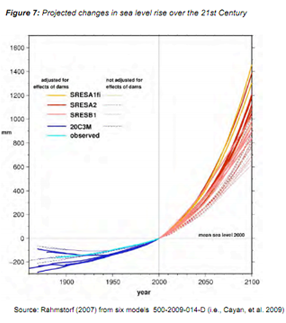There was a good article in the LA Times last Sunday about an issue that is going to be really important in Carpinteria: Coastal cities prepare for rising sea levels. It talks about Newport Beach’s effort to develop an adaptation strategy for Balboa Island, the densely developed spit of land that separates Newport Harbor from the ocean.
The focus on adaptation is a marked shift for cities such as Newport Beach that just a few years ago had made few preparations for the effects of climate change or were focusing on reducing their carbon footprints. Even as the California Legislature passed a landmark law in 2006 to reduce greenhouse gas emissions, few coastal cities had any plans to confront rising waters on their own shores.
“The state of preparedness was close to zero in terms of looking forward to climate change and what it’s going to bring,” said Susanne Moser, a social science researcher at the Woods Institute for the Environment at Stanford University, who has surveyed coastal cities and counties about planning for rising sea levels. “Since then there’s been an explosion of interest on the local level.”
I mentioned the article during the “items raised by commissioners” section of last night’s Planning Commission meeting, along with mentioning some of the other adaptation resources I’ve been reading lately. In response, Jackie Campbell, the city’s Director of Community Development, talked about some of the activities that Carpinteria is already engaged in on climate change (membership in ICLEI, participation at SBCAG in setting greenhouse gas reduction targets). She also pointed out that the city’s budget is really tight these days in terms of being able to to pay for the kind of consulting services that other cities have used to pursue adaptation initiatives.
I pretty much expected that response, having corresponded with her already about the issue. I understand where she’s coming from, and don’t expect her to just drop everything and jump on the bandwagon. This is a marathon, not a sprint. There’s a long road ahead in terms of building awareness and support in Carpinteria before we’ll be ready to take the kinds of actions that effective adaptation will require.
It felt good to get the information out there, though. Now I need to keep the pressure on to make sure the right people are looking at it.
Update: Here are my comments from the March 7 meeting:
…and here is Jackie Campbell’s director’s report:
Another recent article from the Times was not concerned with climate change directly, but was interesting in its own right, and did contain an interesting fact about local sea level rise: Archaeologists find evidence of early maritime explorers.
Archaeologists generally agree that one group of hunters migrated from northern Asia across the land bridge that connected Asia and North America through the region known as Beringia, slaughtering large mammals with spears and arrows fitted with characteristic stone tips known as Clovis points.
But a slowly growing body of evidence hints that a separate group of people, who originated perhaps in Japan, sailed along the coasts of both continents, traveling as far south as Tierra del Fuego and migrating as far inland as the glacial lakes of the Pacific Northwest.
The problem with proving it is that the ocean level was about 200 feet lower then. As sea levels have risen, they have inundated most of the coastal sites where the ancient seafarers may have lived.
To get around the problem, archaeologist Jon M. Erlandson of the University of Oregon and his colleagues studied caves on the Channel Islands that remained above the rising waters. They reported this week in the journal Science that they had discovered middens — garbage disposal areas — containing many bones and tools.
One of the important points to realize in planning for sea level rise is that the ocean’s level really isn’t constant, certainly not on geologic timescales. Even without human-induced climate change, the level of the ocean is constantly rising and falling, and does so by what feels like really large amounts from our short-lived human perspective.
 The California Climate Adaptation Strategy talks about four and a half feet of sea level rise by 2100, and that much and more again in the century that follows, even if we get greenhouse gas emissions under control practically overnight (which seems unlikely), and even without including the effect of melting ice sheets in Greenland and Antarctica (which seem likely to add to the total). I can imagine a Carpinteria that looks pretty much like the Carp of today with four and a half feet of sea level rise, and with a little more effort I can imagine ways of dealing with nine feet. But beyond that my mind starts to boggle.
The California Climate Adaptation Strategy talks about four and a half feet of sea level rise by 2100, and that much and more again in the century that follows, even if we get greenhouse gas emissions under control practically overnight (which seems unlikely), and even without including the effect of melting ice sheets in Greenland and Antarctica (which seem likely to add to the total). I can imagine a Carpinteria that looks pretty much like the Carp of today with four and a half feet of sea level rise, and with a little more effort I can imagine ways of dealing with nine feet. But beyond that my mind starts to boggle.
But the ocean doesn’t care about my bogglement. It will have no problem at all with going on rising for centuries, or even millennia.